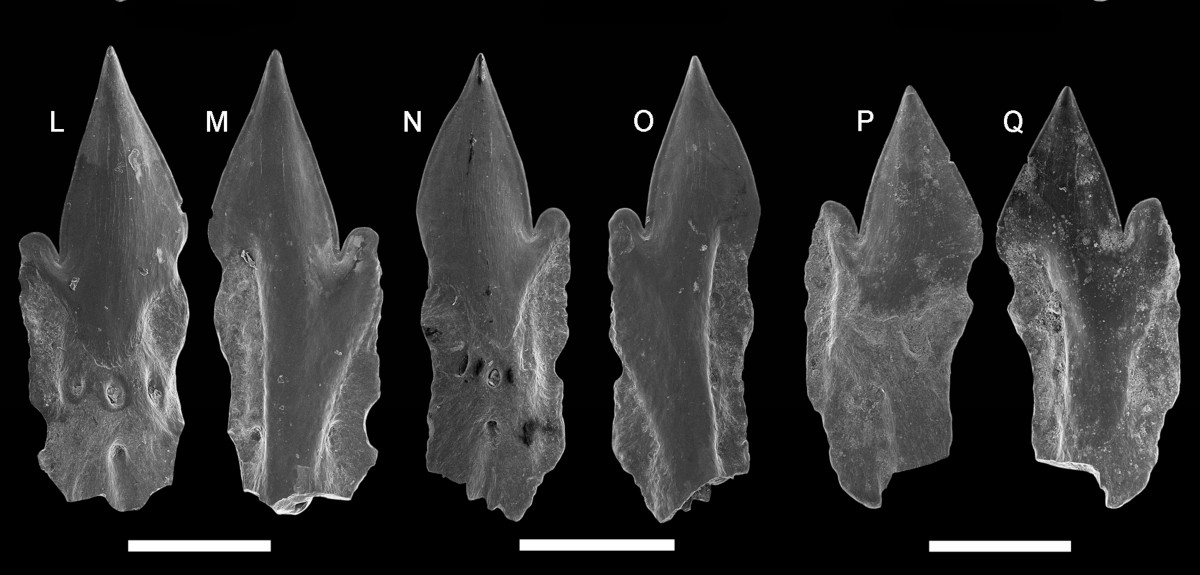Protoxynotus mayrmelnhofi
Feichtinger, Guinot, Straube, Harzhauser, Auer, Ćorić, Kranner, Schellhorn, Ladwig, Thies & Pollerspöck, 2022
Classification: Elasmobranchii Squaliformes Somniosidae
Reference of the original description
Revision of the Cretaceous shark Protoxynotus (Chondrichthyes, Squaliformes) and early evolution of somniosid sharks. Cretaceous Research, 140, Article 105331
Revision of the Cretaceous shark Protoxynotus (Chondrichthyes, Squaliformes) and early evolution of somniosid sharks. Cretaceous Research, 140, Article 105331
Types
Protoxynotus mayrmelnhofi
Holotype: NHMW: 2021/0116/0001; Paratype: NHMW: 2021/0116/0001; NHMW: 2021/0116/0001;
Protoxynotus mayrmelnhofi
Holotype: NHMW: 2021/0116/0001; Paratype: NHMW: 2021/0116/0001; NHMW: 2021/0116/0001;
Description:
Citation: Protoxynotus mayrmelnhofi Feichtinger, Guinot, Straube, Harzhauser, Auer, Ćorić, Kranner, Schellhorn, Ladwig, Thies & Pollerspöck, 2022: In: Database of fossil elasmobranch teeth www.shark-references.com, World Wide Web electronic publication, Version 12/2025
Please send your images of "Protoxynotus mayrmelnhofi" to info@shark-references.com

Protoxynotus mayrmelnhofi sp. nov. L-M Holotype (NHMW/2021/0116/0001), lower jaw: L lingual, M labial; N-O Paratype (NHMW/2021/0116/0002), lower jaw: N lingual, O labial; P-Q Paratype (NHMW/2021/0116/0003), lower jaw: P lingual, Q labial, Upper Maastrichtian, Waidach near Nussdorf, Austria. Scale bars equal 500 μm

Protoxynotus mayrmelnhofi sp. nov. L-M Holotype (NHMW/2021/0116/0001), lower jaw: L lingual, M labial; N-O Paratype (NHMW/2021/0116/0002), lower jaw: N lingual, O labial; P-Q Paratype (NHMW/2021/0116/0003), lower jaw: P lingual, Q labial, Upper Maastrichtian, Waidach near Nussdorf, Austria. Scale bars equal 500 μm
Material
Three complete, (including the holotype), and four fragmentary preserved lower jaw teeth (NHMW/2021/0116/0001e0007) [30999]
Three complete, (including the holotype), and four fragmentary preserved lower jaw teeth (NHMW/2021/0116/0001e0007) [30999]
Description
Original diagnosis after Feichtinger et al. (2022) [30999]: Labio-lingually compressed, asymmetrical but delicate teeth not exceeding a height of 1.8 mm and a width of 0.5 mm. Teardrop-shaped and smooth cusp flanked by a well-rounded distal heel. Broad extension (sinuosity) of enameloid towards the base on lingual face with basally adjacent pronounced bulge, exhibiting one medio-lingual foramen and a central foramen. Nutritive groove on basal face running from the labial root edge to the central foramen. A pair of margino-lingual foramina is present on the edges of the lingual bulge, slightly higher than the medio-lingual foramen. Labial crown possesses a long apron, bordered laterally by several margino-labial foramina.
Original diagnosis after Feichtinger et al. (2022) [30999]: Labio-lingually compressed, asymmetrical but delicate teeth not exceeding a height of 1.8 mm and a width of 0.5 mm. Teardrop-shaped and smooth cusp flanked by a well-rounded distal heel. Broad extension (sinuosity) of enameloid towards the base on lingual face with basally adjacent pronounced bulge, exhibiting one medio-lingual foramen and a central foramen. Nutritive groove on basal face running from the labial root edge to the central foramen. A pair of margino-lingual foramina is present on the edges of the lingual bulge, slightly higher than the medio-lingual foramen. Labial crown possesses a long apron, bordered laterally by several margino-labial foramina.
References

Bioluminescence and repeated deep-sea colonization shaped the diversification and body size evolution of squaliform sharks. Proceedings of the Royal Society B-Biological Sciences, 292(2042), Article 20242932
DOI: 10.1098/rspb.2024.2932

Ecological restructuring of North Tethyan marine vertebrate communities triggered by the end-Cretaceous extinction. Proceedings of the National Academy of Sciences of the United States of America, 122(22), Article e2409366122
DOI: 10.1073/pnas.2409366122

Haie und Rochen an der Kreide-Paläogen-Grenze. Fossilien, 3/2024, 48–57
Shifts in composition of northern Tethyan elasmobranch assemblages during the last millennia of the Cretaceous. Cretaceous Research, 142, Article 105414
DOI: 10.1016/j.cretres.2022.105414
Revision of the Cretaceous shark Protoxynotus (Chondrichthyes, Squaliformes) and early evolution of somniosid sharks. Cretaceous Research, 140, Article 105331
DOI: 10.1016/j.cretres.2022.105331

Bioluminescence and repeated deep-sea colonization shaped the diversification and body size evolution of squaliform sharks. Proceedings of the Royal Society B-Biological Sciences, 292(2042), Article 20242932
DOI: 10.1098/rspb.2024.2932

Ecological restructuring of North Tethyan marine vertebrate communities triggered by the end-Cretaceous extinction. Proceedings of the National Academy of Sciences of the United States of America, 122(22), Article e2409366122
DOI: 10.1073/pnas.2409366122

Haie und Rochen an der Kreide-Paläogen-Grenze. Fossilien, 3/2024, 48–57
Shifts in composition of northern Tethyan elasmobranch assemblages during the last millennia of the Cretaceous. Cretaceous Research, 142, Article 105414
DOI: 10.1016/j.cretres.2022.105414
Revision of the Cretaceous shark Protoxynotus (Chondrichthyes, Squaliformes) and early evolution of somniosid sharks. Cretaceous Research, 140, Article 105331
DOI: 10.1016/j.cretres.2022.105331

















